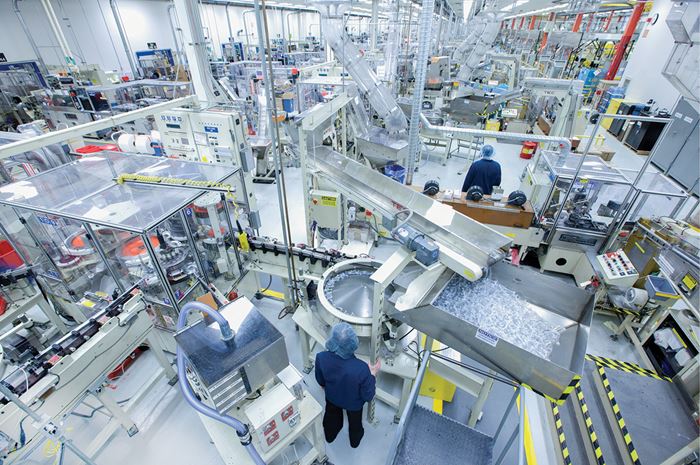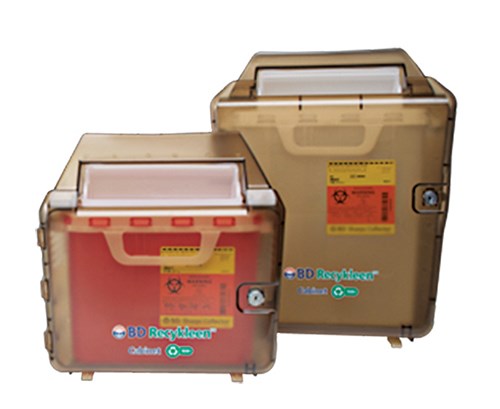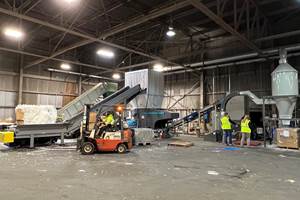BD’s Holistic Approach To Sustainability
For medical device giant Becton Dickinson, sustainability takes into account material selection, manufacturing, packaging, logistics, waste reduction, energy use and reduction, and more.
“We treat each other with respect. We accept personal responsibility. We always seek to improve. We do what is right.”
These core values form the foundation of the worldwide business of BD (Becton, Dickinson and Company), headquartered in Franklin Lakes, N.J. An iconic brand among the world’s leading suppliers of injection molded syringes, extruded catheters, and a myriad of other medical devices, BD has been innovating since 1906, when it built the first-ever facility in the U.S. to manufacture needles and syringes. It sold its first glass syringe in 1897 and acquired half-right for the patent a year later (for $40).
The BD Medical business segment today is a $4 billion operation focused on providing innovative solutions to reduce the spread of infection, enhance diabetes treatment, and advance drug delivery. Taking into account its Diagnostics and Biosciences segments, BD (bd.com) is a $7.7 billion, publicly traded business that employs nearly 30,000 in more than 50 countries around the world. And it continues to invest heavily in support of its commitment to develop new healthcare products and solutions, having spent $472 million in R&D for its 2012 fiscal year.
BD has roughly 50 manufacturing facilities worldwide, where hundreds of extrusion and injection molding machines are deployed to make a gamut of syringes, IV catheters, laboratory products, etc. Its corporate purpose of “helping all people live healthy lives” includes what the firm calls a “triple bottom line” that balances strong financial performance, environmental stewardship, and advancing social responsibility.
The latter two goals form the basis of BD’s sustainability efforts, which for a company the size and scope of BD can be a tall order to implement. Sustainability can mean different things to different people. But for BD, it is a broad term that takes into account material selection, manufacturing, packaging, logistics, waste reduction, energy use and reduction, and more.
BD is a member of Practice Greenhealth, a U.S.-based nonprofit that promotes sustainability in healthcare. The company is a co-sponsor of its Greening the Operating Room Initiative, which seeks to develop practices that reduce environmental impact, save costs, and improve efficiencies in hospital operating rooms. Two years ago, BD also became a member of the Environmentally Preferred Purchasing (EPP) Business Leadership Coalition. This group of companies is working with Practice Greenhealth, Group Purchasing Organizations, and hospitals in the U.S. to encourage more sustainable products and services in healthcare as part of the Practice Greenhealth Greening the Supply Chain initiative.
At BD, a commitment to sustainability did not start out as a dictate driven down by corporate management to design and production engineering. In fact, it was initiated at the plant level and was pushed up to the executive level. “Our sustainability effort started back in 2008,” recalls Gregory Butler, BD’s director of global supply chain stewardship for The Office of Global Sustainability (OGS). “Our chairman at the time was visiting our sites around the world, seeing and hearing about things that plants were doing on their own.” According to Scott Hudson, BD’s global manager of energy, emissions, and facilities, these included initiatives to minimize packaging, use more energy-efficient lighting, switch to all-electric molding machines, and conduct audits to identify leaks in the compressed-air systems.
The boss was impressed. So the next step was to coordinate these efforts so that improvements made in one facility were brought to the attention of others. “We brought in a consultant to help us develop a strategy, and the outcome of that was The Office of Global Sustainability,” states Butler. “Teams were formed internally at all locations, with the objective of getting our footprint as small as possible. This facilitated the exchange of ideas from one location to another. It happens all the time now: One site experiments with an energy-savings idea and shares the cost-savings opportunities with others. Our employees around the world have embraced this initiative and have taken ownership of it. Every one of our sites around the word has a ‘BD Green’ champion.”
In 2011, OGS established the Energy, Waste and Emissions Steering Committee. This group was put in charge of establishing programs to achieve 2015 Sustainability Targets and align environmental practices with business objectives. Together with manufacturing and business personnel, the OGS creates standards, develops tools and training materials, and increases capability and engagement. Its activities include:
•Energy workshops for facility managers in the U.S. and Europe;
•Monthly training materials;
•Self-auditing tools aligned with Lean and Continuous Improvement programs;
•Specifications for energy-efficient equipment;
•Standards for energy management;
•Waste reduction, recycling, and emissions reduction;
•Certifications and audits.
Twelve BD sites have implemented ISO 14001-certified environmental management systems. Two plan to obtain certification by 2014.
And this effort was not just limited to BD’s manufacturing operations; the Franklin Lakes headquarters, for example, recently converted to LED lighting and is evaluating its performance. BD’s newest distribution center, a 720,000 ft² facility in Four Oaks, N.C., became BD’s first Leadership in Energy and Environmental Design (LEED) Gold certified distribution center in 2011. LEED is a certification developed by the U.S. Green Building Council to rate a facility’s environmental friendliness.
The distribution center is generating nearly 1 MW of electricity, almost 20% of its needs, from four acres of rooftop solar panels. It’s a valuable precedent for the installation of future renewable energy projects at other BD locations. As of this writing, BD secured LEED certification at 11 more sites. BD requires all new construction and renovations costing more than $1 million to be submitted for LEED certification.
ENERGY EFFICIENCY IMPROVEMENTS
Beginning in 2011, BD held energy-efficiency training workshops for facility and engineering managers throughout Europe and North America. A number of global sites conducted energy-usage evaluations to identify and prioritize conservation opportunities and best practices.
To date, BD has completed more than 400 energy-related projects, yielding substantial savings in electricity and other sources of energy. Highlights from these efforts include:
•Reducing electricity costs by 44% at a distribution center in Oakville, Ont., by switching to more energy-efficient lights, installing motion sensors, and improving HVAC controls.
•Cutting electricity use by 10% at its Erembodegem, Belgium, site through improvements to the HVAC systems and office lighting as well as employee awareness campaigns.
•Slashing electricity use by 66% in a section of its manufacturing facility in Dun Laoghaire, Ireland, by switching to more efficient manufacturing equipment.
•Installing new energy-efficient chillers at five manufacturing sites.
BD’s renewable energy program is another key part of its sustainability efforts. Remarks Butler, “We don’t run any wind farms, but by increasing the demand for new renewable energy, we have created an incentive for more wind farms to be built. What we do is purchase renewable energy credits and participate in green power purchase programs offered by local utility companies. In 2012, 35% of the energy we consumed on a global basis was from wind. That was up from 25% in 2011. In the U.S., 60% of the power we used came from wind.”
In 2011, BD joined a group of companies supporting WindMade, the first global consumer labeling program to certify companies that source at least 25% of their power from wind energy, notes Jason Saft, manager of sustainability programs for BD Medical Surgical Systems.
That same year, BD used the Global Water Tool from the World Business Council for Sustainable Development (WBCSD) to better understand its water footprint. BD facilities located in water-stressed and water-scarce areas were identified, and the company has begun developing a systematic water management strategy. Through 2012, BD’s water consumption has decreased by 28% normalized (17% absolute) in comparison to 2008 consumption.
Despite substantial water conservation efforts, customer requirements for additional washing processes increased the company’s total water use. However, its sustained conservation efforts and successful process changes have continued. For example, the BD Medical facility in Columbus, Neb., is saving more than 75 million gallons of water per year by eliminating single-pass cooling for the plant’s compressed-air system.
The medical-device giant realizes that sustainability is an ongoing effort. For its manufacturing operations, it is constantly evaluating motor designs or variable-frequency drives for efficiency, states Hudson. It makes regular use of ceramic heater bands or barrel-insulation blankets on much of its molding equipment to minimize the need for heating and subsequent HVAC cooling. It has redesigned several products to cut down on material consumption. For example, the needle shield on the BD Autoguard Catheter now uses 26% less material than the previous design, notes Saft.
In 2011, the company launched the BD Emerald 5 ml Syringe, which uses up to 30% less material than other syringes. This reduces the environmental impact during the manufacture, transportation, and disposal of the product.
Packaging operations have been consolidated where possible to permit, for example, 200 syringes to be placed in a single box as opposed to 100 previously.
As part of the BD ecoFinity program, BD also collects, treats, shreds, and recycles polypropylene-based “sharp” waste into new sharp-collection containers and other products. In operation for three years, the program has diverted more than 500,000 lb of material that otherwise would have been landfilled or incinerated.
BD also extends sustainability down the supply chain through its Sustainable Procurement strategy, which directs its vendors to take responsibility for their own environmental impact. The company has developed the BD Expectations for Suppliers Guide that outlines its standards for suppliers regarding environmental stewardship, ethical practices and governance, and social responsibility.
In 2011, selected BD suppliers participated in its first two Procurement Sustainability Summits. Associates and suppliers worked together to generate ideas for improving sustainability practices, such as identifying Green Continuous Improvement projects. In a sustainability audit at a supplier of rubber stoppers used in syringes, BD found more than $100,000 in savings opportunities by examining waste, energy conservation, and electricity contracting.
BD is continuously working to reduce the materials used in its product packaging and find effective alternatives that are recyclable, reusable, and not derived from fossil fuels.
Its sustainable packaging efforts focus on two areas: increasing packaging efficiency and sourcing recycled materials for use in outer packaging. The company has established companywide sustainable packaging criteria to improve recyclability, reduce material, and increase shipping efficiencies from packaging designs.
It is also adopting and integrating into its own Design for Environment awareness training the Design Guidelines for Healthcare Plastics Recycling released by the Healthcare Plastics Recycling Council.
Related Content
Purpose-Built System Enhances Capacity and Flexibility for Recycler
A Boston recycler invested in a turnkey shredding, granulation and elutriation system to expand its plastics reclaim business.
Read MoreThe Importance of Mass Balance in Chemical Recycling
Approaches to mass balance can dramatically impact calculations of recycled content.
Read MoreHow to Extrusion Blow Mold PHA/PLA Blends
You need to pay attention to the inherent characteristics of biopolymers PHA/PLA materials when setting process parameters to realize better and more consistent outcomes.
Read MoreInside the Florida Recycler Taking on NPE’s 100% Scrap Reuse Goal
Hundreds of tons of demonstration products will be created this week. Commercial Plastics Recycling is striving to recycle ALL of it.
Read MoreRead Next
Beyond Prototypes: 8 Ways the Plastics Industry Is Using 3D Printing
Plastics processors are finding applications for 3D printing around the plant and across the supply chain. Here are 8 examples to look for at NPE2024.
Read MoreFor PLASTICS' CEO Seaholm, NPE to Shine Light on Sustainability Successes
With advocacy, communication and sustainability as three main pillars, Seaholm leads a trade association to NPE that ‘is more active today than we have ever been.’
Read More























